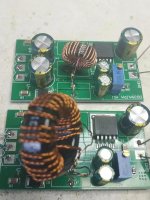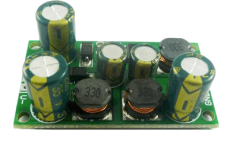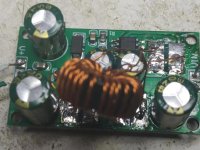This is a handy and affordable little dual-polarity output module that's available on Aliexpress here for about $5. I
should point out that I bought mine on Taobao but the modules look to me to be identical whichever platform you
happen find them on.
I fired this up and made a few measurements, primarily I started off looking at its efficiency. The quiescent is
decently low (10mA or so) but delivering around 4W of output at +/-24V I found the efficiency rather dismal
for a switcher and definitely lower than as advertised on the vendor's Ali page. I was getting about 55% which
meant around 4W was going somewhere - initially I wasn't sure just where. I figured best to wait a while and
then poke around with my finger to see what was getting hot as 4W wouldn't be possible to hide for very long.
It took less than a minute to detect that the toroidal inductors were to blame, everything else was cool. After
extracting them and taking the shrink jacket off one, it looks like this :
My LCR meter confirms a nice low DCR but at 100kHz, the resistance is close to 3ohm indicating
high AC losses. The switching chip operates at 180kHz so obviously this particular material isn't a
great choice in this application. From its colour scheme (yellow/white) its probably a type 26
which is about the cheapest toroid going, a great choice for a CLCLC power supply filter but
unsuitable for high frequency work. I have quite a few different sizes of Sendust cores so why not
try some of those, they're much better at HF.
Before that though I wanted to see if I could understand the schematic, a switcher with 3
inductors isn't something I've encountered before.
Last edited:


